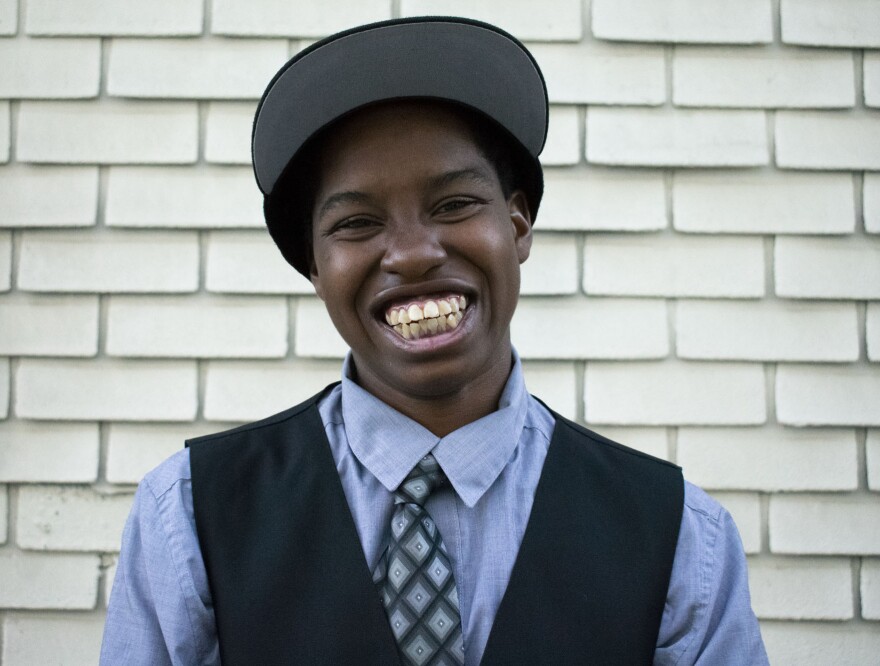Last year, more than 2,000 Washoe County youth experienced homelessness, according to local health officials. Jasmin Dardy, a youth who says she has struggled with abuse and trauma, spoke about what led her to the streets with KUNR's Stephanie Serrano.
What’s ahead includes talk of sexual violence and suicide and may not be suitable for all listeners. If you're struggling with thoughts and feelings about harming yourself, please call the U.S. National Suicide Prevention Lifeline at 800-273-TALK (8255).
Editor's Note: The below story was updated to remove potentially identifying information related to the victims of alleged sexual abuse.
Jasmin Dardy performed her spoken word at a recent community event hosted by Our Town Reno, a street reporting project on homelessness and a media partner of KUNR. She worked on the poem for months and while the voice you hear is brave, standing strong in front of a crowd, it was the first time she shared her story publicly.
Here's an excerpt of Jasmin's powerful poem: I feel so ashamed and embarrassed. Every day, I ask myself, 'Where will I sleep tonight? Where can I go? Who can I run to? Who can I ask for help? Will you help me?'
Originally from Alabama, Dardy and her sisters were adopted, all as young babies; however, the home she was brought into was a ways from safe.
“I just feel like being adopted was good, but not good,” Dardy says. “For the longest time, I kind of hated it because why do those things you did to us? I never knew adopted parents would do what my adopted mom and my adopted dad did to us. Everything that's happened in my life has left me traumatized.”
Dardy says she witnessed the sexual assualt of others during her childhood and that there was physical abuse and drug abuse going on around her. Eventually, Dardy and her sisters were separated and sent to group homes, but things didn’t get better. Then, in high school, her favorite teacher passed away, and she lost all hope.
"I was a troubled kid. I lost everything I could ever have. I was failing school. I just didn't care for life. As a person, I didn't care. I was just done. My teacher passed away and, not only did my teacher pass away, but I didn’t know my biological mom."

Dardy attempted to take her own life more than once. Her experiences took her down a path she says she didn’t ask for, but they eventually led her to the one place she now calls home: The Eddy House in Reno.
“71 percent of Eddy house kids said that they are safer living on the streets of downtown Reno than they were in their own homes,” said Michele Gehr director of the Eddy House. “We're seeing an increase in the community in child abuse, domestic violence and drug and alcohol abuse in the home. Those are the top three reasons for Eddy House youth to be homeless in this community.”
The Eddy House is a trauma care drop-in center for homeless youth. According to a report by the U.S. Department of Health and Human Services, 40 percent of homeless youth across the country flee from home, due to sexual violence. Locally, they often couchsurf or pool their money together to stay in one of the weeklys, which means they may be homeless two, three or seven days of the week, or none at all.
Because of that inconsistency, Gehr works to make the Eddy House a family-like environment.
Dardy instantly felt at home.
“This is the place I am myself; I am comfortable; I'm not judged. They encourage me, they listen to me and they motivate me. This is the one place that I can say really helped me," Dardy explained.
Gehr is slated to work with nearly 1,000 youth this year and the number is growing.
Nico Colombant who leads Our Town Reno, the street reporting project, has identified a difference between the older and younger homeless demographic.
“The young homeless population is often a hidden population because they don’t fit that stereotype of what people think looks like a homeless person,” Colombant said.
Dardy says that by sharing her story, she hopes to help address some of the misconceptions people may have about the homeless.
"People think that homeless people are out there because they're homeless, but what if they're getting away from domestic violence? What if they're getting away from the drugs? What if they're trying to get away from something? Because that’s how I was; I’m just getting away, and I think people are just so quick to judge homeless people, but you don’t know their story,” Dardy said.
According to researchers at the University of Nevada, Las Vegas, Nevada ranks highest in youth homelessness in the U.S. On any given night, Gehr says there are roughly 400 to 600 young people living on the streets in Reno.






